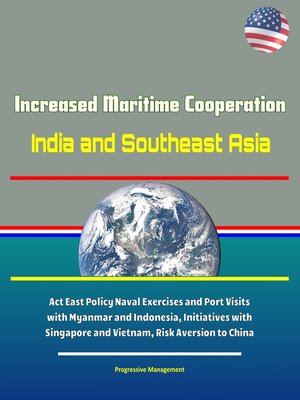Increased Maritime Cooperation
ebook ∣ India and Southeast Asia--Act East Policy Naval Exercises and Port Visits with Myanmar and Indonesia, Initiatives with Singapore and Vietnam, Risk Aversion to China

Sign up to save your library
With an OverDrive account, you can save your favorite libraries for at-a-glance information about availability. Find out more about OverDrive accounts.
Find this title in Libby, the library reading app by OverDrive.



Search for a digital library with this title
Title found at these libraries:
| Library Name | Distance |
|---|---|
| Loading... |
This report has been professionally converted for accurate flowing-text e-book format reproduction. India's primary method for security cooperation in Southeast Asia is through maritime engagement, predominantly through naval exercises, port visits, and capacity development with partner navies. This thesis examined why and how this maritime cooperation has increased since the implementation of the Act East Policy. The research used two approaches to identify and understand India's maritime engagement. First, a quantitative approach measured naval exercises and port visits from 2013 to 2018 and found that India has increased its maritime cooperation with Myanmar and Indonesia, which implies India's interests in border security. It also revealed India's lack of engagement with South China Sea claimant states, which suggests risk aversion to China. Second, the researcher used a framework to measure the scope and depth of maritime cooperation between India and Southeast Asian countries to explore India's maritime engagement from 2015 to the end of 2018. Findings reveal an increase in both maritime security and capacity development initiatives between India and Indonesia, Myanmar, Singapore, and Vietnam. Both frameworks illustrate India's increased maritime engagement in Southeast Asia, and show that the reasons for the increased cooperation are the desire of Southeast Asian countries for capacity development and India's economic motivations since 2015.
I. Introduction * A. Major Research Question * B. Significance of the Research Question * C. Literature Review * 1. Increased Maritime Cooperation between India and Southeast Asia * 2. India's Motivations for Increased Maritime Cooperation * 3. Southeast Asia's Motivations for Increased Maritime Cooperation * D. Potential Explanations and Hypotheses * E. Research Design * F. Thesis Overview * Ii. Increased Asean-India Maritime Cooperation, 1990-2018 * A. Introduction * B. 1990-2000: Beyond the "Look East Policy" * C. 2001-2009: Terrorism and Nontraditional Maritime Threats * 1. Terrorism * 2. Humanitarian Assistance/Disaster Relief * 3. Antipiracy * D. 2010-2018: Enhanced ASEAN-India Engagement * 1. 2011-2013: Strategic Partnership * 2. 2014-2017: Act East Policy * 3. 2018: Enhanced Maritime Initiatives * E. Conclusion * Iii. India's Bilateral Maritime Cooperation With Countries In Southeast Asia * A. Introduction * B. India's Increased Naval Cooperation In Southeast Asia * C. Bilateral Maritime Cooperation * 1. Brunei * 2. Cambodia * 3. Indonesia * 4. Malaysia * 5. Myanmar * 6. Philippines * 7. Singapore * 8. Thailand * 9. Timor-Leste * 10. Vietnam * D. Emerging Patterns and Concluding Comments * Iv. Conclusion * A. Findings * B. Implications * C. Areas For Further Research
This compilation includes a reproduction of the 2019 Worldwide Threat Assessment of the U.S. Intelligence Community.







